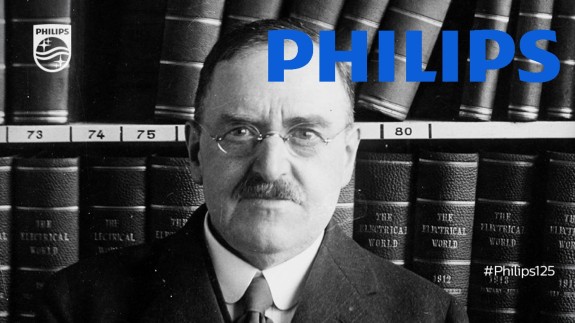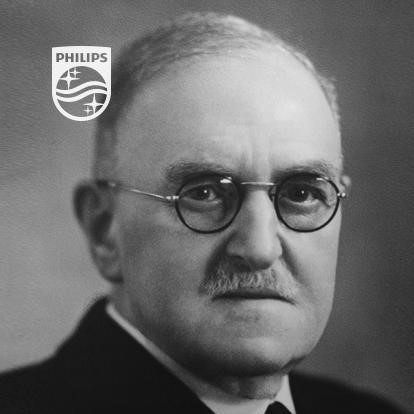Can you believe? Founder of Philips, relative of Karl Marx
The Philips brand was founded in Eindhoven, the Netherlands, in 1891 by Gerard Philips, Karl Marx's maternal cousin.

With a brand history of more than 120 years, Philips continues to successfully maintain its leadership in technological innovation, which it captured at the end of the 19th century.
The birth of the Philips brand dates back to 1891. The company, which was founded in Eindhoven, the Netherlands by Gerard Philips, the maternal cousin of German economist and philosopher Karl Marx, entered the sector with the production of carbon filament lamps. In this period, Gerard Philips was following the lighting technologies, which witnessed many innovative inventions, to expand his company. Increasing its product range with light bulbs and some electrical appliances over time, the company achieved a rapid growth momentum.
Gerard Philips (1858-1942)
Gerard Philips was born on October 9, 1858 in Zaltbommel, Netherlands. His father, Frederik Philips, worked in a bank and, in his spare time, was involved in the coffee and tobacco trade. Thanks to his father's good business, little Gerard had the opportunity to receive a good education. He studied mechanical engineering at Delft Technical University, where he was accepted after his high school education. He started work at a shipyard in Scotland in 1884. During this period, he worked with a research team for 1 year at the Department of Natural Philosophy at Glasgow University. Then, he moved to London and started working for Anglo-American Brush Electric Light Corporation Ltd., which has a significant power in the British electricity market. Since 1887, he undertook the management of various projects of the company in Europe.
While still a student, Gerard Philips aimed to establish his own company one day and focused on lighting technologies. After the education he received at the university and the experience he gained in business life, all he needed was capital support to establish his own company. He founded his company in 1891 with a capital of 75,000 guilders provided by his father. In 1895, his brother Anton became a partner in the company. Anton Frederik Philips handled the sales, while he handled the management and R&D himself. With only 10 employees at the beginning, the company has become one of the most important players in the field of lighting technologies in the Dutch market in just a few years. In 1912, the Philips Brothers established their limited company with a capital of 6 million gulden.
Philips During World War I
In 1914, Gerard Philips opened his research laboratory, which would enable him to make breakthroughs in innovation. As a matter of fact, according to Philips, a company's lasting success in the industry was not possible only with the quality of its products. Companies that stand out in the field of innovation could not only increase the quality of their products, but also strengthen their position in the sector by pioneering many innovations. Thanks to the new production techniques to be developed, high production capacity could be achieved and leadership in the world market could be achieved. And it happened just as he thought. In the first quarter of the 20th century, the company became one of the leading bulb manufacturers not only in the Netherlands but also in Europe, thanks to the new technologies it developed.
Prior to World War I, the company managed to generate a large turnover from the sales of the tungsten-wire metallic lamp and half-watt light bulbs filled with argon gas, which it developed during its R&D studies. The new technologies developed for these products enabled the factory to increase its production capacity. So much so that the daily production amount has reached the level of 80 thousand bulbs. The number of people employed in the company has exceeded 3,700. However, as it became difficult to find raw materials and finished goods during the war, there was a serious decrease in production capacity. During this period, the company began investing in glass, corrugated board and hydrogen gas fields.
Philips Arga lamps were first introduced to the market in 1915.
After the war, the company introduced the first medical X-ray tube in 1918. Soon after, it focused on products that were very difficult to manufacture under the conditions of that time, such as vacuum tubes. The company, which had branches only in the USA and France before the war, wanted to expand its production and sales activities in Europe after the war. The main priority of the company in the field of sales was to eliminate the wholesalers and sales representatives and present their products to the consumers through its own sales network. In order to turn the increase in production capacity into a better sales success, Philips Brothers turned their limited company into a holding in 1920.
The Rise of the Philips Brand
Gerard Philips retired in 1922 and Anton Frederik Philips assumed the chairmanship and CEO position of the holding. During this period, the company accelerated its research on radio and television production. Philips radios, first introduced in 1927, opened a new chapter in the company's history. The partnership it established with the British electronics company Mullard played a large part in the company's entry into this field. As a result of this cooperation, both companies reached a high production capacity in radio production and increased their market power in the field of electronic products. Moreover, they established a radio station called PCJ and started broadcasting. Today, this radio channel, which continues its activities under the name Radio Netherlands, has continued its broadcasts uninterruptedly until today, except for the Nazi occupation period.
In the 1930s, Philips radios dominated the market.
Total sales of Philips radios exceeded 1 million in 1932, making the company the world's largest manufacturer of radio and radio tubes. As a result of the cooperation with the German electronics company Valvo, the company made a rapid entry into the German market. The Germans especially showed great interest in light bulbs. In 1933, the total number of light bulbs sold by the company reached 100 million. In addition, the production of medical x-ray equipment was started in the USA. The work on television production since 1925 resulted in positive results in 1938 and the first Philips branded television was exhibited at the Utrecht Fair. In 1939, the first electric shaver, Philishave, was introduced to the market. During this period, the number of employees employed by Philips exceeded 45 thousand.
Philips During World War II
On May 9, 1940, company executives received information that the Netherlands would be occupied by the Nazis the next day. Thereupon, they moved the company on paper to the Netherlands Antilles. And they left the Netherlands to go to the USA with the capital they could take with them. During the World War II period, the company continued its activities as an American company. However, Philips' production facility in Eindhoven fell into the hands of the Nazis. And the electronic equipment in the facilities contributed to the advance of the occupation forces in Europe. During the war, this facility was the only industrial target bombed by allied forces.
In the 1940s, Philips continued its activities as an American company.
The Nazi takeover of the Eindhoven manufacturing facility was used by rival electronics companies in the post-war era to defame Philips as volunteering support for the Nazis. However, there is no evidence that Philips provided electronic material support to the Nazis. II. Despite this rhetoric to prevent the rise of Philips in the European market after World War II, Philips continued to grow with a rapid upward momentum in this period as well. In particular, thanks to his innovative discoveries on transistors and integrated circuits, he set standards in electronic products.
Philips in the World Market
After radio and television, Philips turned to musical instruments in the 1960s and concentrated on sound recording systems. The compact audio cassette was launched in 1963, which set the standards for tape recording. In the 1970s and when the need for energy increased, the company intensified its work on energy-saving light bulbs. In the 1980s, the company strengthened its position in the world market with many innovative inventions that facilitate the processing, storage and transmission of image, sound and digital data. The compact discs (CD), which emerged as a result of his studies on optical telecommunication systems, revealed a brand new technology that is still in use today
Since the 1960s, Philips has increased its market power in audio technologies.
In 1984, the number of televisions Philips sold exceeded 100 million. A year later, the company entered the Chinese market. Continuing to grow throughout the 1990s, the company managed to set an example in terms of planned and sustainable growth as well as innovation in its sector. Entering the healthcare industry at the same time, the company adopted a completely human-oriented approach in its product design processes. He made the medical tools he developed easier for patients and simpler for clinicians. In 1997, he launched the DVD he developed as a result of his partnership with Sony. DVDs, which carried Philips' name to the top in technological innovation, enabled Philips to reach a great market power in the home electronics industry today.
In the 2000s, the company continued to grow in the consumer electronics industry. It focused on televisions, videos, sound systems, communication tools and accessories in the audio and imaging product line. Shaving machines, face shapers and care products and hair clippers came to the fore in personal care products. In the category of maternal and child care, breast pumps and care products, as well as food machines and sets, attracted great attention in the market.

